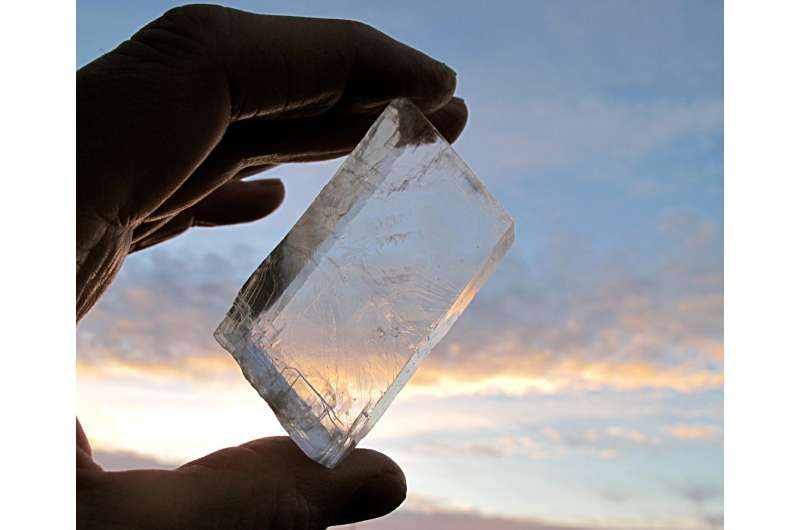July 27, 2016 report
Experimentation suggests Vikings could have used sunstone to navigate

(Phys.org)—A team of researchers from several institutions in Hungary has conducted experiments meant to test the possibility that the Vikings actually did use sunstones to navigate. In their paper published in Proceedings of the Royal Society A, the team describes the experiments they carried out, their results and why they now believe it is possible to use a sunstone as a navigational aid during times when the skies are covered with clouds.
The exploits of the Vikings have been well documented—they conducted raids across Europe from the late 790s till 1066, when the Normans famously conquered England. But as more recent research has established, they were also long-distance seafaring travelers, venturing as far as the Middle East and North America. But how they found their way across vast stretches of ocean has been a bit of a mystery, particularly during times when there were no stars or sun in the sky to guide them. Some historical evidence such as Icelandic legends have mentioned travel under snowy skies using sunstones and a study of a Viking wreck conducted in 2002 revealed that a crystal (Icelandic spar) had been onboard that was found near other implements used for navigation.
Modern sunstone is a type of crystal that, when viewed from different angles, offers a spangled optical effect. In this new effort, the researchers have conducted a study designed to test the possibility that such crystals could really have helped Vikings find their way across the ocean.
They believe it was a three step process: (1) determine the direction of light from the sky using the sunstone held up to the sky, (2) use that information to determine the direction of sunlight and then (3) use a shadow stick to determine which direction was north. The team previously conducted tests to measure the accuracy of the first two steps and, apparently satisfied with the results, have now conducted experiments with the third.
To test the third step, the researchers asked 10 volunteers to try to work out the position of the sun in a digital planetarium using dots to stand in for results of using a sunstone. After conducting a total of 2,400 trials, the researchers report that 48 percent resulted in producing an accurate reading to within just one degree. They noted also that the volunteers did best when the virtual sun was near the horizon, showing that the method worked best at dawn and dusk. The team suggests their results indicate that it was possible that the Vikings used sunstones to navigate under cloudy skies.
More information: Dénes Száz et al. North error estimation based on solar elevation errors in the third step of sky-polarimetric Viking navigation, Proceedings of the Royal Society A: Mathematical, Physical and Engineering Science (2016). DOI: 10.1098/rspa.2016.0171
Abstract
The theory of sky-polarimetric Viking navigation has been widely accepted for decades without any information about the accuracy of this method. Previously, we have measured the accuracy of the first and second steps of this navigation method in psychophysical laboratory and planetarium experiments. Now, we have tested the accuracy of the third step in a planetarium experiment, assuming that the first and second steps are errorless. Using the fists of their outstretched arms, 10 test persons had to estimate the elevation angles (measured in numbers of fists and fingers) of black dots (representing the position of the occluded Sun) projected onto the planetarium dome. The test persons performed 2400 elevation estimations, 48% of which were more accurate than ±1°. We selected three test persons with the (i) largest and (ii) smallest elevation errors and (iii) highest standard deviation of the elevation error. From the errors of these three persons, we calculated their error function, from which the North errors (the angles with which they deviated from the geographical North) were determined for summer solstice and spring equinox, two specific dates of the Viking sailing period. The range of possible North errors ΔωN was the lowest and highest at low and high solar elevations, respectively. At high elevations, the maximal ΔωN was 35.6° and 73.7° at summer solstice and 23.8° and 43.9° at spring equinox for the best and worst test person (navigator), respectively. Thus, the best navigator was twice as good as the worst one. At solstice and equinox, high elevations occur the most frequently during the day, thus high North errors could occur more frequently than expected before. According to our findings, the ideal periods for sky-polarimetric Viking navigation are immediately after sunrise and before sunset, because the North errors are the lowest at low solar elevations.
Journal information: Proceedings of the Royal Society A
© 2016 Phys.org



















